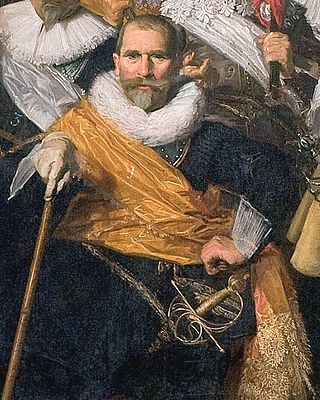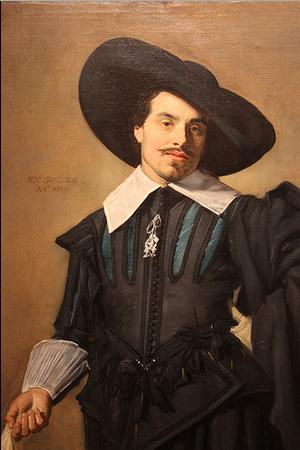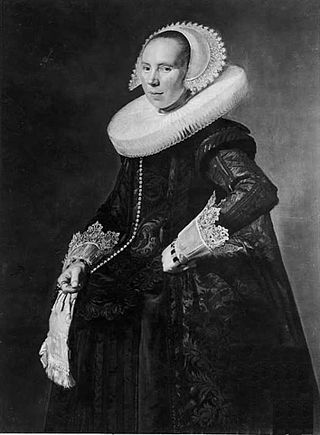
Frans Hals the Elder was a Dutch Golden Age painter, chiefly of individual and group portraits and of genre works, who lived and worked in Haarlem.

Willem Claesz. Heda was a Dutch Golden Age artist from the city of Haarlem devoted exclusively to the painting of still life. He is known for his innovation of the late breakfast genre of still life painting.

The Frans Hals Museum is a museum located in Haarlem, the Netherlands.

Cornelis Corneliszoon van Haarlem was a Dutch Golden Age painter and draughtsman, one of the leading Northern Mannerist artists in the Netherlands, and an important forerunner of Frans Hals as a portraitist.

Dirck Hals, born at Haarlem, was a Dutch Golden Age painter of merry company scenes, festivals and ballroom scenes. He played a role in the development of these types of genre painting. He was somewhat influenced by his elder brother Frans Hals, but painted few portraits.
Johannes Cornelisz. Verspronck was a Dutch Golden Age portrait painter from Haarlem.

Cornelis Schrevel was a Dutch physician and scholar.
Schrevelius is a Latinized Dutch name that means scrivener.

Theodorus Schrevelius was a Dutch Golden Age writer and poet.

The Banquet of the Officers of the St George Militia Company in 1616 refers to the first of several large schutterstukken painted by Frans Hals for the St. George civic guard of Haarlem, and today is considered one of the main attractions of the Frans Hals Museum there.

The Officers of the St George Militia Company in 1639 refers to the last and largest schutterstuk painted by Frans Hals for the St. George civic guard of Haarlem, and today is considered one of the main attractions of the Frans Hals Museum there.

Michiel de Wael, was a Dutch brewer and citizen of Haarlem, best known today for his portraits painted by Frans Hals. His grandfather, also a brewer, was one of the first Calvinists in the city and was involved in the Siege of Haarlem.

Johan Claesz van Loo, was a Dutch brewer, owning De Drie Leliën in Haarlem, best known today for his portrait painted by Frans Hals.

Gijsbert Claesz van Campen, was a Dutch cloth merchant of Haarlem who is most famous today for his family portrait painted by Frans Hals. The sitters in this painting have been identified by Pieter Biesboer as the family of Gijsbert Claesz. van Campen and is today split into three parts; the left half is in the collection of the Toledo Museum of Art, with an extra baby lower left added by Salomon de Bray in 1628, the center half is in the collection of the Royal Museums of Fine Arts of Belgium, Brussels, and a third fragment on the far right from a European private collection make up the three known surviving pieces of the original portrait. These three segments were reunited at the Toledo Museum of Art for an exhibition October 18, 2018 – January 6, 2019. The exhibition traveled to the RMFAB in Brussels from February 2 – April 28, 2019 and the Collection Frits Lugt in Paris, from June 8 – August 25, 2019.

The Meagre Company, or The Company of Captain Reinier Reael and Lieutenant Cornelis Michielsz Blaeuw, refers to the only militia group portrait, or schutterstuk, painted by Frans Hals outside of Haarlem. Today the painting is in the collection of the Amsterdam Museum, on loan to the Rijksmuseum, where it is considered one of its main attractions of the Honor Gallery. Hals was unhappy about commuting to Amsterdam to work on the painting and, unlike his previous group portraits, was unable to deliver it on time. The sitters contracted Pieter Codde to finish the work.

Cornelis Coning or Koning, was an engraver and mayor of Haarlem.

Claes Duyst van Voorhout is an oil-on-canvas portrait painting by the Dutch Golden Age painter Frans Hals, painted in 1638 and now in the Metropolitan Museum of Art, New York City.

Portrait of Cunera van Baersdorp is an oil-on-panel painting by the Dutch Golden Age painter Frans Hals, painted in 1625 and now in a private collection. It is considered a pendant portrait to the Portrait of a Man Standing, now identified as Cunera's husband Michiel de Wael.

Family Group in a Landscape is an oil-on-canvas painting by the Dutch Golden Age painter Frans Hals, painted c. 1645-1648, and now in the Museo Thyssen-Bornemisza, in Madrid.
The portrayed person is possibly Cornelis Schrevelius (1608-1664), a medical doctor in Haarlem between 1632 and 1641. After 1641 he was dean of the Latin school of Leiden where he succeeded his father. He was the son of Theodorus Schrevelius (1572-1649) dean of the Latin school of Haarlem and later of Leiden who was an acquaintance of Frans Hals and wrote about him in his history of Haarlem (1647/1648). Theodorus was portrayed by Frans Hals in 1617. There are several portraits of Cornelis known. He was first portrayed in 1624 in a familyportrait with his parents, brother and sister. Lateron in the 1650's and 1660's there must have been some paintings from which still some engravements exist. In 1661 he was portrayed with his own family by Jacob Torenvliet. This portrait by Hals was possibly in 1704 still in the possession of his son Theodorus (1639-1704) under the name "Quacksalver". The painting was used around 1685 by an English engraver for a commercial engraving "The mountback doctor and his merry Andrew". Probably the little flattering title gives his own opinion about his former profession while he was a famous Latinist and asked several times for a medical professorship at the University of Leiden which he refused.

















